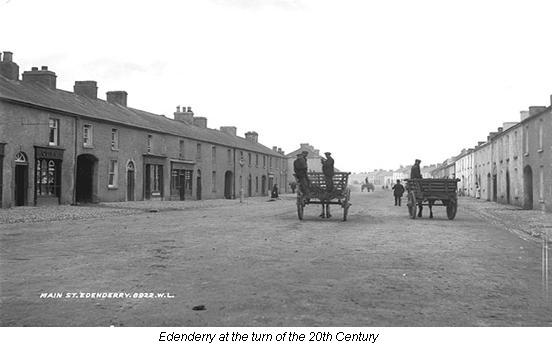The games of hurling and football were played in the area prior to the formation of the GAA but seem to have ceased to be played by the 1880s. The travel writer Jonathon Binns noted in 1836 about Edenderry that: ‘in the afternoon they play at football and other games’. Two years before the Great Famine hurling was being played in Edenderry, perhaps not to the same code of conduct that we have come to realise today. On this occasion in March 1843 the Dictrict Inspector of the R.I.C. a Mr D.W. Verling wrote from Edenderry that ‘the Edenderry Races were finally fixed on yesterday to come off on next Monday, the 13th.instant. Your presence will be very necessary as I received a hint that a faction fight is likely to occur from what I understand by enquiry the origin was a dispute in some hurling match in Meath some time ago. I have applied for 100 men stating the circumstances to the County Inspector’. In King’s County (now Offaly) landlords such as Capt Thomas Bernard of Kinnitty often arranged as entertainment hurling matches to be played on the lawn of Kinnitty castle as much for his enjoyment as for that of his tenants. (Evidence indeed that the people of south Offaly got a head start on us with the camáns!)
But what of Edenderry in 1884 at the foundation of the GAA? What type of town was it and why did the GAA’s message fail to take root for seven years? An examination of the town 125 years ago highlights how our forbearers were slightly better circumstanced when it came to employment and the provision of goods and services in the town. Edenderry’s major employer was Alesbury’s Timber factory which was described at this time as ‘doing a large amount of business in steam bending, wheel making, turning, chair making etc, and gives a great deal of employment’. In 1881 the town could boast one insurance agent, one sawmill and timber yard, one painter, an auctioneer, fifteen spirit dealers, thirteen grocers, a draper, a baker, four butchers, four car owners, two coachbuilders, two blacksmiths, two tailors, two watchmakers, two banks, three boot makers. In total there was sixty eight commercial undertakings in the town. Despite the provision of employment there was a high percentage of paupers living in the town about whom it was stated that ‘they would eat grass or die of starvation rather than give up their homes and go into the workhouse’. The population had only decreased slightly from 1,661 in 1861 to 1,577 in 1891 when the GAA was eventually formed in Edenderry. The town and surrounding districts of Edenderry were united through the Home Rule party formed to win legislative self government for Ireland. A Home Rule had been formed in 1876 in Edenderry at McKeon’s Hotel and indeed the town had been described as a hotbed of nationalism wherein many patriots resided. The Land League and the struggle for land against landlords was particularly active in Edenderry; notable speakers on occasion in the town included Isaac Butt and Charles Stewart Parnell. Amongst the Home Rulers of Edenderry included Reddy, Patterson, Moran, O’Kennedy and Usher. Why then did this overt nationalism not transfer itself into an effort to establish a branch of the GAA in 1884? The promotion of education for the youth it appears was foremost on the minds of the town nationalist elders where in June 1883 a reading room and library was established. This new centre was also to provide ‘the patriotic young men of the town and neighbourhood’ a meeting place to ‘hold social and intellectual reunions such as concerts, lectures, etc’. The Edenderry Lawn Tennis club was also particularly active at this time and could boast large numbers amongst their membership which included Home Rule and Land League activists. In April 1887 the members were asked to give up their grounds by the Marquis of Downshire’s agent Thomas Murray on the Fair Green.. Murray it seems was exacting revenge because several of the clubs members had failed to pay the rent owed to the estate.
The major pastime of the people of Edenderry was Cricket. Cricket teams in the area included Cloncannon, Drumcooley, Alesbury’s, M.P. O’Brien’s Universal Providing Stores and Edenderry. Despite connotations of the game with ‘Britishness’ it appears that the sporting pastime of the young men in Edenderry in the 1880s was cricket. A typical team sheet from a game against Kilbeggan in August 1890 survives. On this occasion Edenderry were represented by T Harte, P Gowran, E Traynor, T Fulton, P Bannon, T Connell, W Traynor, W Foley, T Foley, C Traynor, P Swords. In The Midland Tribune 6 April 1889 there appeared an advertisement highlighting the importance of cricket in the locality while also emphasising the apathy in regard to Gaelic pastimes: ‘The Edenderry Cricket club will soon be in operation for this season/ how is it that we are so backward in regarding such sports as football, hurling in this thriving population of 2,000’. Also extremely popular pastimes were coarsing, clay pigeon shooting and hockey. The Edenderry Hockey club was amongst the most successful in the midland area and had players selected for provincial and international duty. The Clay Pigeon club met regularly near Killane although as an expensive recreational pastime it may have only included the upper echelons of society. Ironically the GAA was founded in the year when the people of the town were greatly divided. The great divide in Irish society at this time resulted from the divorce scandal involving Charles Stewart Parnell, Kitty O’Shea and her husband Capt O’Shea. The people of Edenderry were particularly divided; the anti-Parnellites led by the priest Fr John Kinsella who described Parnellites as ‘the men of no intelligence’. The formation of the GAA in 1891 provided the basis for the bringing together of political enemies and though fractured nationalist politics was soon in the ascent at Edenderry. Matt Mangan described the first tentative steps to organise the GAA in Edenderry in the 1890s and was elected as secretary of the first hurling club in Edenderry namely ‘The Old Reds’ with Hugh Donaghue as captain. Those games were played 21 a side with two goalposts at a distance of 30 to 32 feet between each, and two goalposts with a lath across the top in between them at both ends of the pitch. An examination of the earliest recorded team which played against Rhode at the slopes of Croghan Hill highlights that despite the formation of the club in 1891 securing players to play was a constant struggle. That team called the John Boyle O’Reilly’s named after the dead Fenian was: P Gerathy (capt), John Mooney, Hugh Donaghue, T McCarthy, J Corrigan, J Nolan, Larry Bell, T Fulton, J ‘Miller’ Grehan, M Hallion, Ted Groome, Peter Kane, W Mooney, James Mulraney, W Mulraney, Paddy Cullen, T Byrne, George Reddy, Larry Mallen, Jack Cosh, John Dunne. The 1911 census of Ireland recently made available online by the National Archives of Ireland provides some information on many of these players some of whom would have been only fourteen or fifteen years of age in 1891. In 1911 Larry Mallen was living on the Carrick road aged 33 and employed as a Tailor; George Reddy aged 32 a harness maker living at New Row; Larry Bell was 35 and from Blundell Street as was Thomas Fulton aged 44; the captain of the team Patrick Gerathy of New Row was 39 in 1911 and lived at 13 New Row; John Corrigan a postman was living at 29 New Row; William Mooney of Blundell Street was a general labourer and aged 45; John ‘Miller’ Grehan was a labourer and 16 when he first played for the reds; Peter Kane was an agricultural labourer of Blundell Street aged 38 and finally Ted Groome, a midfielder was a farm labourer, aged 34 and lived on the Carrick road. Tentative steps indeed to form the GAA in Edenderry. Today the GAA in Edenderry remains an important social and cultural outlet for the young men and women of the parish. In an introduction to the ‘gospel’ of Edenderry GAA, ‘The Tale of the Reds’ produced in 1997, former President of the GAA, the late John Dowling told the Gaels of Edenderry to ‘celebrate wisely and well and may the next one hundred years be as successful as the past was glorious’. As the GAA, just like all sporting and cultural organisations in 21st century Edenderry struggle from an ever changing and diverse society (and the problems it brings) let the words of a famous and revered citizen of the town (Fr John McWey) ring loudly: ‘May the torch be handed on from generation to generation and may it never be dimmed, always remembering that the association is bigger than one individual’.
This short article on the formation of the GAA in Edenderry was originally presented to mark the occasion of ‘Lá na gClub’ GAA 125 Anniversary Celebrations on 10 May 2009. The largest sporting organisation in Ireland today, the GAA was founded in Hayes Hotel, Thurles 125 years ago and according to its founder Michael Cusack ‘spread like wildfire’ into every town and village in Ireland. Why then did that ‘wildfire’ take longer to reach Edenderry? What was Edenderry like in 1884? What were the pastimes of the local people? Why did the GAA not take hold for 7 years? How did the GAA influence the locality in its early years?
Sports and Pastimes
The Formation of the GAA

News
'Spread Like Wildfire? The formation of the GAA in Edenderry'
November 8, 2018
Introduction

